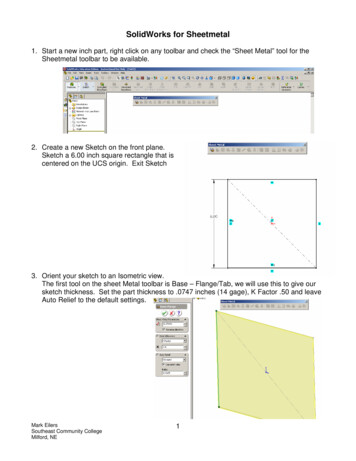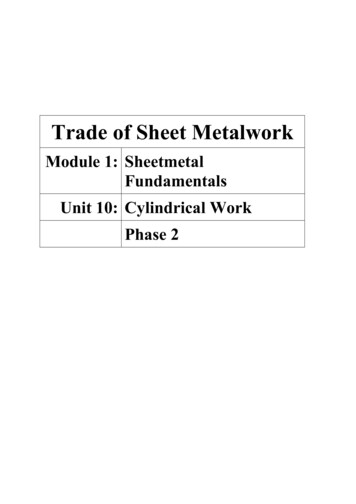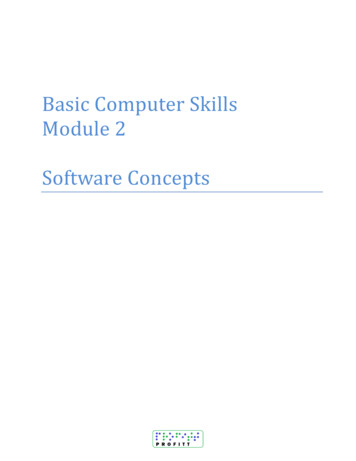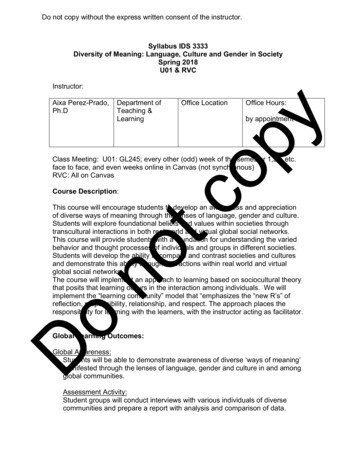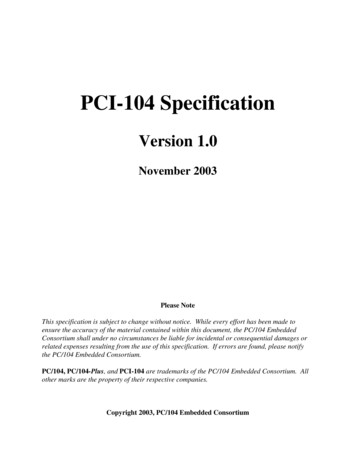
Transcription
Trade of Sheet MetalworkModule 1: SheetmetalFundamentalsUnit 12: RivetingPhase 2
Trade of Sheet Metalwork – Phase 2Module 1Unit 12Table of ContentsList of Figures . 5List of Tables . 6Document Release History . 7Module 1 – Sheetmetal Fundamentals . 8Unit 12 – Riveting. 8Learning Outcome: . 8Key Learning Points: . 8Training Resources: . 9Exercise: . 9Key Learning Points Code: . 9Fasteners for Sheet Metal . 11Rivets . 11Tinman’s Rivets . 11Riveting . 12Types of Rivets . 12Rivet Sizes . 12Forming Rivet Heads . 13Spacing Rivet Holes. 14Riveting Seams . 15Abbreviations . 16Single-Strap Butt Joint . 17Double-Strap Butt Joint . 17Riveted Joints . 18Single Riveted Lap Joint . 18Double Riveted Lap Joint . 18Types of Rivet and Rivet-Head . 19Defects in Riveted Joint . 20The Strength of Riveted Joints. 22Selecting the Correct Size of Rivet . 22Common Causes of Failure in Riveted Joints . 24Diameter of Rivet used in Assembly . 24Rivet Spacing . 27Pop Riveting . 28Percentages & Averages . 29Interconversion with Fractions & Decimals . 29Ratios & Proportion . 30Unit 123
Trade of Sheet Metalwork – Phase 2Module 1Unit 12Self Assessment. 31Answers to Questions 1-2. Module 1.Unit 12. 32Index . 33Unit 124
Trade of Sheet Metalwork – Phase 2Module 1Unit 12List of FiguresFigure 1 - Drilling/Riveting . 10Figure 2 - Tinman's Rivets . 11Figure 3 - Types of Rivets . 12Figure 4 - Rivet Sizes . 12Figure 5 - Cross Section of Rivet Head . 13Figure 6 - Forming Rivet Heads . 13Figure 7 - Spacing Rivet Holes . 14Figure 8 - Longitudinal Seams . 14Figure 9 - Riveting Seams. 15Figure 10 - Types of Riveted Joints . 18Figure 11 - Standard Types of Rivet Heads . 19Figure 12 - Countersunk Riveting of Thin Material to Thick Material . 19Figure 13 - Shearing of Rivet. 23Figure 14 - Crushing of the Metal. 23Figure 15 - Splitting of the Metal . 23Figure 16 - Tearing of the Plate . 23Unit 125
Trade of Sheet Metalwork – Phase 2Module 1Unit 12List of TablesTable 1 - Abbreviations for Written Statements . 16Table 2 - Common Defects in Riveting . 21Table 3 - Rivet Sizes . 24Table 4 - Recommended Hole Clearances for Various Diameters of Rivet . 26Unit 126
Trade of Sheet Metalwork – Phase 2Module 1Unit 12Document Release HistoryDateVersion11/07/06First draft04/04/142.0Unit 12CommentsSOLAS transfer7
Trade of Sheet Metalwork – Phase 2Module 1Unit 12Module 1 – Sheetmetal FundamentalsUnit 12 – RivetingDuration – 3 HoursLearning Outcome:By the end of this unit each apprentice will be able to: Describe different types of rivets and their applicationsCalculate rivet lengths for rivet types, sizeAssemble components for rivetingAssemble components using universal & countersink rivetsMake countersink rivet holes to suit rivetsKey Learning Points:RkDifferent metals, their properties and benefits.RkBenefits of riveting as against other jointingmethods.RkComponent preparations.RkErrors made preparing parts for riveting.RkCorrect methods used when preparing parts to beriveted.SkCountersinking of rivet holes.SkClosing of plates and forming rivet head.SkAvoiding work marks from rivet dolly/set andsnap.MRivet length calculations.MAverages, percentages, ratios and proportion.Unit 128
Trade of Sheet Metalwork – Phase 2Module 1Unit 12Training Resources: ToolkitBench ViceMaterials – 0.8mm mild steel, 0.9mm half hard copper, 1.5mm aluminiumCombined rivet set and snapDemonstration and handouts from instructorRivets of various types and lengthsDollyExercise:Rivet together the parts described in Figure 1 to the given tolerances.Key Learning Points Code:M MathsD DrawingP Personal SkillsSk SkillUnit 12RK Related Knowledge Sc ScienceH Hazards9
Trade of Sheet Metalwork – Phase 2Module 1Unit 12Figure 1 - Drilling/RivetingUnit 1210
Trade of Sheet Metalwork – Phase 2Module 1Unit 12Fasteners for Sheet MetalThere are several types of fasteners used to join pieces of sheet metal and to attach sheetmetal to other materials. This chapter will cover the commonly used types of fasteners,their characteristics and standard designation and the various types of welding used insheet metal work.RivetsBefore modern welding techniques came into common use, riveting was one of the mostcommon methods for joiing sheet metal. Since the advent of the new welding techniquesand modern machines that form seams on sheet metal, riveted seams are not so commonin modern sheet metal work. However, the sheet metal worker will often use rivets onsheet metal too heavy for machine forming and where welding is not practical.Rivets may be made from steel, copper, brass, aluminium or other materials. Standardsfor rivets sizes and shapes have been put forward by several agencies.Tinman’s RivetsThey are small flat headed rivets with relatively short lengths. The size number oftinman’s rivets are determined by the approximate weight per thousand rivets. Eachweight of rivet has a definite diameter and length.Figure 2 - Tinman's RivetsUnit 1211
Trade of Sheet Metalwork – Phase 2Module 1Unit 12RivetingRiveting may be done by hand or by machine. When the job is performed by hand, as isusually the case in sheet metal work, it is done with a hammer and rivet set.Types of RivetsMany types of rivets are used in the sheet metal shop. The most common types are thetinman's rivets, flathead, snap head (also called roundhead) and pop rivets.The countersunk is used where a flush surface is desired, and the snaphead whenexceptional strength is required.Figure 3 - Types of RivetsRivet SizesThe size of the tinman's rivets are determined by the weight of 1,000 rivets i.e. 1 lb. rivetsweigh 1 lb. per thousand, 2 lb. rivets weigh 2 lb. per thousand.Flathead rivets vary in diameter from 3/32" to 7/16" in steps of 1/32". Other rivets vary insize with 1/8" and 3/16" snaphead rivets being the most popular in the sheet metal shop.F1athead, snaphead and countersunk rivets may be purchased in various lengthsdepending upon the thickness of the metal being joined.There are no definite rules to follow in selecting the size of a rivet. In general the lengthshould be sufficient to protrude through the pieces being joined, from l½ times thediameter of the rivet. This allows ample material for forming the head.Figure 4 - Rivet SizesUnit 1212
Trade of Sheet Metalwork – Phase 2Module 1Unit 12Forming Rivet HeadsThe shallow cup-shaped hole shown by the cross section view of a rivet set is used toform the head on the rivet. The deep hole is used to draw the sheets and rivet together andalso to draw the rivet directly through thin sheeting without previously punching a hole.The outlet on the side allows the metal slugs to drop out. The rivet set selected shouldhave a hole, slightly larger than the diameter of the rivet. A good job of riveting can bedone with not more than six normal blows of the hammer and after a little practice thisnumber can be cut by half.A skilled sheet metal worker will perform the operation in sequence by striking a blow onthe rivet set, one blow to flatten the rivet down and another blow on the rivet set to formthe head.Figure 5 - Cross Section of Rivet HeadFigure 6 - Forming Rivet HeadsUnit 1213
Trade of Sheet Metalwork – Phase 2Module 1Unit 12Spacing Rivet HolesRivet holes should be spaced according to the job specification. The space from the edgeof the metal to the centre of the rivet line should be at least twice the diameter of therivet, thus preventing the rivet from tearing out. The minimum distance between therivets should be three times rivet dia. approx. The maximum distance between rivetsshould never be such that the material is allowed to buckle between them.Figure 7 - Spacing Rivet HolesThe method of spacing rivet holes for longitudinal seams in pipes is different from themanner in which the rivet holes are spaced for cross seams.Although there are various methods of laying out holes for longitudinal seams, the metalstrip procedure is generally preferred when the same job is laid out repeatedly.This method consists of using a narrow strip of metal in which the required number ofholes have being evenly spaced and pricked punched. The strip is then laid on the edge ofthe metal and the location of the holes marked by prick punching through the strip intothe metal. One draw back to this method is, as the strip is continually used the holesbecome enlarged and accurate marking becomes difficult.Care should be taken to see that the strip is not reversed when switching to the oppositeside of the work, since the distances from the end holes are not alike.Figure 8 - Longitudinal SeamsUnit 1214
Trade of Sheet Metalwork – Phase 2Module 1Unit 12Riveting SeamsWhen making round pipe with riveted seams, the section of the pipe should be formedwith the burred edge of the hole on the outside of the pipe. After selecting the correct sizerivets and rivet set and hammer, place a rivet in one end hole and place the job on a stake.Rivet as described previously, proceed to rivet other end and centre of cylinder and thenrivet alternately right and left of centre.Figure 9 - Riveting SeamsUnit 1215
Trade of Sheet Metalwork – Phase 2Module 1Unit 12AbbreviationsTermAbbreviationAcross FlatsA/FBritish StandardBSCentresCRSCentre lineCL orChamferedCHAMCheese HeadCH HDCountersunkCSKCountersunk headCSK HDCounterboreC’BOREDiameter (in a note)DIADiameter (preceding a dimension)ØDrawingDRGFigureFIGHexagonHEXHexagon headHEX HDMaterialMATLNumberNOPitch circle diameterPCDRadius (in a note)RADRadius (preceding a dimension)RScrewedSCRSpecificationSPECSpherical diameter or radiusSPHERE Ø or RSpotfaceS’FACEStandardSTDUndercutU’CUTTable 1 - Abbreviations for Written StatementsUnit 1216
Trade of Sheet Metalwork – Phase 2Module 1Unit 12Single-Strap Butt JointTo make a riveted butt joint it is necessary to use a separate piece of metal called a 'strap'to join the two component edges.Double-Strap Butt JointWhen two cover plates are riveted on either side of a butt joint, the joint is known as a'double-strap butt joint'.When single or double straps are used for riveted butt joints the rivets may be arranged asfollows:Single riveted: One row of rivets on each side of the butt;Double, triple or quadruple riveted: In which case the chain or zig-zag formation may beemployed.Unit 1217
Trade of Sheet Metalwork – Phase 2Module 1Unit 12Riveted JointsRiveting is a method of making permanent joints. The process consists of drilling orpunching the plates to be riveled, inserting the rivet, and then closing it by an appliedcompression force so that it completely fills the hole and forms a rigid joint.A variety of riveted joints is used in construction and fabrication work:1.2.3.4.single riveted lap joint;double riveted lap joint;single-strap butt joint;double-strap butt joint.Figure 10 - Types of Riveted JointsSingle Riveted Lap JointThis is the simplest of all riveted joints and is widely used for joining both thick and thinplates. The plates to be joined are overlapped by a short distance. Then a single row ofrivets, conveniently spaced along the middle of the lap, completes the joint.Double Riveted Lap JointA lap joint with two rows of rivets is known as a double riveted lap joint. Sufficientoverlap must be provided to take a double row of rivets. This type of joint may have thetwo rows of rivets arranged in a square formation. This is known as chain riveting. If therivets are arranged diagonally to form triangles, this is called zig-zag riveting.Unit 1218
Trade of Sheet Metalwork – Phase 2Module 1Unit 12Types of Rivet and Rivet-HeadThe standard types of rivet heads are shown in Figure 11 and Figure 12. Also shown isthe way in which thin material is joined to thick material with countersunk rivets.Tinners and flat-head rivets are used in most general sheet metal fabrications, where themetal is very thin and little strength is required. The countersunk head is used when aflush surface is required, and the roundhead or snaphead is most widely used where thejoint must be as strong as possible. Mushroom head or 'knobbled' rivets, as they are calledin the steel construction industry, are used where it is important that the rivet head doesnot stick up above the surface too much. They are used on outer fuselage skins of aircraftin order to decrease 'drag'. In the case of steel chutes and bunkers they are used to reduceobstruction on the inside surfaces.Pan head rivets are very strong and are widely used for girders and heavy constructionalengineering.'Tinners' are similar to flat-head rivets. They are made of soft iron and are usually coatedwith tin to prevent corrosion and to make them easier to soft solder.Always use the correct rivet for a particular metal to be riveted. When rivetingaluminium, for example, use aluminium rivets; and when riveting copper use copperrivets.Figure 11 - Standard Types of Rivet HeadsFigure 12 - Countersunk Riveting of Thin Material to Thick MaterialUnit 1219
Trade of Sheet Metalwork – Phase 2Module 1Unit 12Defects in Riveted JointWhen making joints with rivets, the following points should be followed to prevent manycommon defects:1. use the correct allowance for edge clearance and pitch when marking out;2. all drilled or punched holes should be made to the correct clearance size to suit therivet diameter, or as specified on the drawing;3. remove any 'burrs' from around the edges of all holes before finally assembling theparts to be joined;4. ensure that holes are correctly aligned and matched before inserting the rivet;5. use the proper type of rivet as specified on the drawing;6. use rivets of the correct length;7. when inserting rivets, do not attempt to force or drive them into the hole;8. always use the correct tools for the job.Some of the common forms of defects associated with riveted connections are shown inTable 2.Unit 1220
Trade of Sheet Metalwork – Phase 2Module 1Unit 12Cause of Riveting DefectResultant EffectSheets not closed together– rivet not drawn upsufficiently.Weak joint. Rivet shank swellsbetween the plates.Rivet holes not matched.Weak misshapen head.Not enough shank protruding to form correctly shaped head.Rivet deformed and does not completelyfill the hole.Insufficient holeclearance.Rivet not completely ‘drawn through’.Not enough shank protruding to formhead.Original head of rivet ‘stands proud’, the formed head isweak and misshapen.Hole too large for rivet.Hole not filled.Rivet tends to bend and deform.Head weak and poorly shaped.Rivet set or dolly notstruck square.Badly shaped head off-centre.Drilling burrs notremoved.Not enough shank protruding toform the correct size head.Sheet damaged by riveting tool.Plates or sheets not closed together.Unequal heads.Rivet too short.Not enough shank protrudingto produce correct shapedhead.Plate surface damaged. Countersinking not completelyfilled.Rivet too long.Too much shank protruding toform required head.‘Flash’ formed around head(Jockey cap). Countersinking over-filled.Table 2 - Common Defects in RivetingUnit 1221
Trade of Sheet Metalwork – Phase 2Module 1Unit 12The Strength of Riveted JointsA riveted joint is only as strong as its weakest part, and it must be borne in mind that itmay fail in one of four ways:i.ii.iii.iv.shearing of the rivet;crushing of the metal;splitting of the metal;rupture or tearing of the plate.These four undesirable effects are shown in Figure 13 to Figure 16.Note: For design purposes the rivet should only be loaded in shear and its tensile strengthin assuming to be zero.Selecting the Correct Size of RivetTo obtain the full strength of a riveted joint, a rivet of the correct diameter and lengthmust be used. For example, if a rivet of a larger diameter were inserted in a thin sheet, thepressure required to drive the rivet would cause bulging of the thin metal around the rivethead.The diameters of rivets for metal plate work may be determined by use of the followingformula:D 1.25 T (Urwin's formula);where D represents the required diameter of the rivet in inches, and T represents the platethickness in inches.Example: Determine the diameter of rivet required for a plate thickness of 0·25 inches (¼inch).Solution:D 1.25 T 1.25 0.25 1·25 x 0.5 0·625 inches for 5Required diameter8inch.Note: When the thickness of the plate is given in millimetres.1. Convert millimetres to inches (1 mm 0·0394 inches).2. Apply the formula.3. Convert inches to millimetres (1 inch 25·4 mm).Example: Determine the diameter of rivet required for a plate thickness of 12·7 mm.Solution:T 12·7 x 0·0394 0·5 inchesUnit 12(1)22
Trade of Sheet Metalwork – Phase 2Module 1Unit 12D 1.25 T(2) 1.25 0.5 1.25 x 0.707 0·844 inches or 78inches 0·844 x 25·4Requireddiameter 22·5 mmFigure 13 - Shearing of RivetFigure 14 - Crushing of the MetalFigure 15 - Splitting of the MetalFigure 16 - Tearing of the PlateUnit 1223
Trade of Sheet Metalwork – Phase 2Module 1Unit 12Common Causes of Failure in Riveted JointsCause: Diameter of rivet too small compared with thickness of plate. The diameter of therivet must be greater than the thickness of the plate in which it is to be inserted.Prevention: Select the correct diameter rivet for the thickness of the plate.Cause: Diameter of rivet too large compared with thickness of plate. The rivets whendriven tend to bulge and crush the metal in front of them.Prevention: Select the correct diameter rivet for the thickness of the metal plate.Cause: Rivet holes punched or drilled too near edge of plate. Metal is likely to fail bysplitting in front of the rivets.Prevention: Drill or punch the rivet holes at the correct edge distance and use the correctlap allowance for the diameter of rivet selected.Cause: Plates weakened by rivet holes being too close together. Plates tend to rupturealong the centre line of the rivetsPrevention: Punch or drill rivet holes at the correct spacing or 'patch'. In addition removeall burrs from the holes before final assembly.Diameter of Rivet used in AssemblymmMetal Thickness S.W.X.Diameter of rivet (mm)0.80 U221.5871.00 U202.3811.25 U183.1751.60 U163.9692.50 U144.7632.80 U124.763 or 6.3503.55 U106.350 or 7.9384.769.5256.3511.113 or 12.7007.9412.700 or 15.8759.5315.875 or 19.050Code letter U denotes I.S.O. metric preferred series.Table 3 - Rivet SizesUnit 1224
Trade of Sheet Metalwork – Phase 2Module 1Unit 12The length of 'shank' required to form the 'head' of the rivet (i.e. the length standing proudof the sheet surface when the rivet is inserted in the hole and held up tight) depends uponthe form of the head and the 'clearance' between the rivet and the rivet hole. ForROUNDHEAD or SNAPHEAD forms the length of shank required is 1½ to 1¾ times thediameter of the rivet, the Total Length of shank required is this length plus the totalthickness of the plates through which it is inserted.The total length of shank required is equal to the total thickness of the metal to be joinedplus the allowance for making the head, i.e. L T T 1·5DD Diameter of rivetT Thickness of metalL Length of shankExample: What length of 4 mm diameter rivet is required to form a snaphead and jointwo pieces of 1·6 mm sheet metal together?Solution:L T T 1·5D 1·6 1·6 1·5 x 4 mmRivet length 3·2 6 mm 9·2 mmFor the Countersunk Head form, the length of shank required is equal to the diameter ofthe rivet.The total length of shank required is equal to the total thickness of the metal to be joinedplus the allowance for making the head, i.e. L T T D.Example: What length of 9·5 mm diameter rivet is required to form a countersunk headand join two pieces of 4·76 mm plate?Solution:L T T D 4·76 4·76 9·5 mm 19·02 mmRivet lengthUnit 12 19 mm25
Trade of Sheet Metalwork – Phase 2Module 1Unit 12Hole clearance is very important and should be kept to the absolute minimum. Table 4shows the recommended hole clearances for various diameters of rivet.Rivet Diameter (mm)Hole Diameter e 4 - Recommended Hole Clearances for Various Diameters of RivetUnit 1226
Trade of Sheet Metalwork – Phase 2Module 1Unit 12Rivet SpacingRivet holes should be spaced according to the specification of the job. The space ordistance from the edge of the metal to the centre of any rivet should be at least twice thediameter of the rivet to prevent the rivets from tearing out.A useful rule is to make the edge distance equal to 1½ diameters plus 9·5 mm. Themaximum distance from the edge is governed by the necessity of preventing the sheetsfrom 'gaping' and should be limited to 10 times the thickness of the sheet metal or plate.The minimum distance between rivets (known as the 'pitch') should be sufficient to allowthe rivets to be driven without interference or about three times the rivet diameter.The maximum distance between rivets should never be such that the material is allowedto buckle between the rivets and in practice should never exceed 24 times the thickness ofthe sheet.Edge distance Twice the diameter of rivetMinimum lap Four times diameter of rivetGapingThe maximum edge distance is governed by the necessity ofpreventing the sheets from gaping and should be limited to10 times the thickness of the sheet or plate.P 3D (minimum)D Diameter of rivetBuckingCaused by too great a pitch.P 24T (maximum)T Thickness of metalUnit 1227
Trade of Sheet Metalwork – Phase 2Module 1Unit 12Pop RivetingPop rivets, unlike solid rivets, are tubular and are much lighter in weight. They aremanufactured from either aluminium alloy for lightness or nickel for additional strengthand corrosion resistance. They were originally designed for one-sided riveting, by whichrivets can be set in places otherwise inaccessible. One operator is needed, the rivets beingset or clinched with the aid of special hand-held 'lazy tongs' or pliers. Although theirmain application has been in aircraft construction and motor vehicle body building,where it is necessary to join thin material to thicker supporting members and lightness isimportant, they are often used in place of solid rivets for general riveting. They areavailable in diameters 2·4 mm, 3·2 mm, 4 mm and 4·8 m for joining thicknesses up to12·7 mm.A skilled operator may achieve speeds of 20 rivets per minute.Unit 1228
Trade of Sheet Metalwork – Phase 2Module 1Unit 12Percentages & AveragesAverage: An average or mean value of a number of quantities is given by adding thequantities together and dividing by the number of quantities added.An average is often called the "mean value" or an "arithmetic mean".Example: Find the average (mean) of 27·3, 17·8, 21·4, 19·7, 25·1. 27.3 17.8 21.4 19.7 25.15 111.35 22· 26 average (or "arithmetic mean")Percentage: To write one number as a percentage of another number:(a)write the numbers as a fraction(b)multiply by 100Example: Write 36 as a fraction of 300. 36 100100 36 100 36 12%100 13To find a certain percentage of a number:(a)find 1% (divide the number by 100)(b)multiply your answer by the required percentage.Example: Find 45% of 260.2602.6 1%1001% of 260 45% of 260 2.6 x 45 117So: 45% of 260 117Interconversion with Fractions & Decimalsa) To convert a fraction to a percentage (%), simply multiply by 100 and simplify:2 2Example: 100 40%5 5b) To change a decimal to a percentage, multiply by 100 by moving the decimalpoint 2 places to the right:Example:0.75 75%0.125 12.5% (or 12½%)Unit 1229
Trade of Sheet Metalwork – Phase 2Module 1Unit 12Ratios & ProportionRatio: A ratio is a comparison of two quantities. The ratio between two quantities is thequotient obtained by dividing the first quantity by the second. For example, the ratiobetween 3 and 12 is ¼, and the ratio between 12 and 3 is 4. Ratio is generally indicatedby the sign (:), thus 12:3 indicates the ratio of 12 to 3.A Reciprocal or Inverse ratio is the opposite of the original ratio. Thus, the inverse ratioof 5:7 is 7:5.In a Compound ratio, each term is the product of the corresponding terms in two or moresimple ratios. Thus, when:8:2 4; 9:3 3; 10:5 2then the compound ratio is:8 x 9 x 10 : 2 x 3 x 5 5 x 3 x 2720 : 30 24Note: all ratios can be expressed as fractions for use in calculations.Example:12:3 123 4Proportion: Proportion is the equality of ratios. Thus:6:8³ 10:5, or 6:3 :: 10:5The first and last terms in a proportion are called the extremes; the second and third, themeans. The product of the extremes is equal to the product of the m
sheet metal too heavy for machine forming and where welding is not practical. Rivets may be made from steel, copper, brass, aluminium or other materials. Standards for rivets sizes and shapes h
